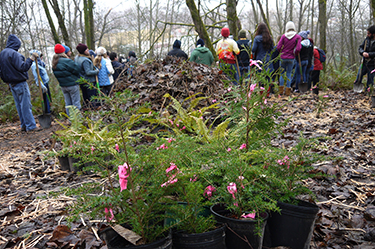|
Subscribe / Renew |
|
|
Contact Us |
|
| ► Subscribe to our Free Weekly Newsletter | |
| home | Welcome, sign in or click here to subscribe. | login |
Environment
| |
 |
September 25, 2014
Preserving Seattle’s largest forest takes a group effort
Nature Consortium

Thomas
|
Located on the western slope of the Duwamish River, the West Duwamish Greenbelt is the largest remaining contiguous forest in Seattle, spanning nearly 500 acres from Alki Point to Burien. Before European settlers arrived, this area was filled with tall evergreen trees such as western red cedar and Douglas fir. The forest has since been the site of timber logging, gravel mining, military operations and a proposed highway.
Due to the immense value this greenbelt provides to the river and the West Seattle community, local nonprofit Nature Consortium is committed to being a steward of the West Duwamish Greenbelt for the lifetime of the organization.
Community benefits
Forested parkland like the West Duwamish Greenbelt is an important part of the urban landscape in Seattle, providing recreation opportunities for residents, habitat for local wildlife, and aesthetic value for the city. The plants and soil in the greenbelt filter pollutants in the water and help reduce erosion and stormwater runoff. As these plants absorb carbon dioxide and other pollutants from the air, they also reduce the effects of global warming.
Pollution from industrial developments in the area has made the Duwamish River one of the most polluted rivers in the country. Despite its changed condition, the West Duwamish Greenbelt remains an important part of the Duwamish watershed because it serves as a natural buffer between the polluted river corridor and nearby residences.
Greenbelt habitat threats
Due to the history of disturbance in the West Duwamish Greenbelt, the quality of habitat has been severely degraded.
After the forest was logged of its old evergreen trees in the late 1800s, new short-lived deciduous trees, such as bigleaf maple and red alder, began to grow in their place. As these deciduous trees reach the end of their lifespan (50-200 years), a new generation of evergreens is needed to continue the life of the forest.
In addition to these aging deciduous trees, many invasive weeds have also taken root in the greenbelt. Invasive plants like Himalayan blackberry, English ivy and Scotch broom compete for the forest’s limited resources, threaten the forest’s biodiversity, and prevent native plants from thriving.
Saving urban forests
Nationwide, urban forests are in decline both in quality and quantity. To combat this issue locally, the Green Seattle Partnership (GSP) was established in 2004 and declared its goal to restore and maintain 2,500 acres of forest within Seattle by the year 2025.
GSP is a public-private partnership between the city of Seattle and Forterra (formerly Cascade Land Conservancy) that seeks to educate and engage residents in longterm stewardship of the city’s urban forests.
Nature Consortium and EarthCorps, which are also members of the partnership, play a major role in carrying out GSP’s restoration goals by providing ecological expertise as well as volunteer recruitment and education.
Since 2003, Nature Consortium has brought volunteers and community members together to help restore habitat in the West Duwamish Greenbelt by removing invasive weeds, amending soil, addressing erosion issues, and planting new native trees and shrubs. The organization’s main restoration goal is to increase native biodiversity and prevent the loss of forest habitat. In 2013 alone, they engaged over 3,100 volunteers and installed over 6,200 native plants.
Restoration at work
As part of the Green Seattle Partnership, Nature Consortium works to restore habitat in the greenbelt and increase recreation opportunities for residents. While Nature Consortium works primarily on forest habitat restoration efforts, Seattle Parks and Recreation also develops and improves trails in the area.
The Green Seattle Partnership, as the coordinator of urban forest restoration in Seattle, tracks the process of restoration through four phases. During phase one, volunteers and GSP staff clear the area of invasive weeds. Himalayan blackberry, English ivy, and Scotch broom top the list for the most common invasive species.
In phase two, native plants are installed to reestablish the natural ecosystem. In phase three, volunteers and staff monitor and maintain the new plantings, install wood mulch as a weed barrier, and conduct additional rounds of weeding. A site can remain in phase three for several years, and much time is required to remove any weeds that begin to grow back.
Phase four sites are considered “fully restored” and support self-sustaining native plant communities requiring minimal maintenance.
GSP cautions volunteers and residents that while a site may be considered to be fully-restored, the urban setting still requires some level of human intervention in the form of monitoring, maintenance and adaptive management to ensure that these areas remain weed-free and ecologically healthy into the future.
Overall, about 114 acres of the West Duwamish Greenbelt are in phases one through four, with the rest not yet in restoration. In accordance with the city-wide goal, GSP aims to bring all areas of the greenbelt into phase four restoration by 2025.
Challenges to success
Ultimately, ecological restoration in an urban setting is an ongoing process and requires repeated efforts rather than a single act. Invasive species are notoriously difficult to eradicate, and other urban influences including polluted air and stormwater runoff pose different challenges to establishing and maintaining healthy ecosystems.
In addition to the human-caused changes in the West Duwamish Greenbelt, there are natural environmental constraints such as steep, landslide-prone slopes, unstable and excessively well-drained soils, and sensitive wetlands and streams. The presence of these sensitive natural features requires specialized restoration techniques and often requires the assistance of professional restoration technicians in addition to community volunteers.
Added to the human impacts and natural site constraints are the challenges of land use throughout the greenbelt. While Seattle Parks and Recreation owns about one-third of the West Duwamish Greenbelt, other areas are owned by private businesses, homeowners, and other municipal and county agencies. Therefore, successful restoration on an ecosystem level requires a unique type of collaboration.
Business partnerships
In addition to government and nonprofits, many local businesses are also getting involved in the West Duwamish Greenbelt restoration. For several years, companies like Boeing have brought employees to volunteer with Nature Consortium. Boeing’s volunteer work in the greenbelt is part of its larger commitment to global corporate citizenship and a healthy Duwamish watershed.
“Boeing looks for community partnerships where our goals are aligned,” says environmental communications officer Joanna Pickup. “We look for organizations that focus on protecting and restoring the watershed and have educational opportunities where employees can actively participate.”
Kira Cha, an avid environmentalist and Boeing employee, was introduced to Nature Consortium after her employer gave her a scholarship to attend a nonprofit board leadership training. In addition to the environmental benefits, Cha says “volunteering with coworkers is a great way to team build and learn about their environmental passions.”
Nature Consortium sees these business partnerships as a highly impactful way to support Duwamish restoration and strengthen the local environmental community.
Monica Thomas is marketing and communications manager at Nature Consortium and holds a bachelor’s degree in environmental science and forest resources.
Other Stories:
- Passive House finds a permanent home in the Northwest
- Survey: Landau Associates
- Survey: HWA GeoSciences
- Survey: Eco Chemical
- Survey: Environmental Resources Management
- Survey: WISErg Corp.
- Survey: Environmental Sciences Associates
- Survey: Farallon Consulting
- These modular classrooms are not old school
- Local firms invent modules to protect Louisiana coast
- Old mining pond becomes new salmon habitat
- Time to jump on contaminated urban properties?
- Tackling toxics with green chemistry
- How biosolids can curb greenhouse gases
- Lower Duwamish: watershed management poster child?
- Is hard water drowning Eastern Washington’s economy?
- Being green is not just about checking boxes
- Carbon-rich tidal wetlands down, but not out
- Survey: Herrera Environmental Consultants



